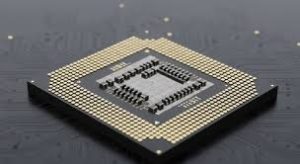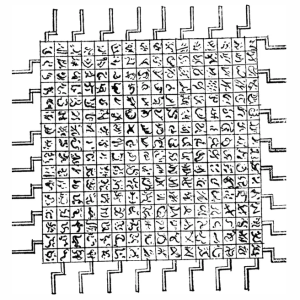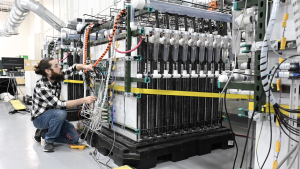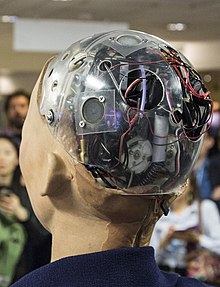“The Birth of the Internet”

Photo from wikipedia: The Sigma 7 was a 32-bit computer introduced in 1966. The Sigma range was popular in the nascent real-time processing market.
By Scott Hamilton
It was a crisp, cool autumn night in Los Angeles when a small group of scientists launched the first test of ARPANET. Student programmer Charley Kline, under the direction of his professor, Leonard Kleinrok, was sitting at the terminal of Kleinrock’s SDS Sigma 7 computer. The goal was to transmit a single message to a second computer in Menlo Park, Calif., about 350 miles away at Stanford Research Institute (SRI). Bill Duvall was waiting at the other end to observe the incoming message.
The goal of ARPANET was to link the digital libraries across the country so scientists working at different universities and government agencies could easily share information and documents. Prior to ARPANET it required photocopying and mailing documents, or sending an original via postal mail. It took several days to share documents in this manner. ARPANET was meant to solve a lot of problems in the scientific community.
As luck would have it, computers in the day were relatively stable, but it seemed that every time they tried something new, things were bound to go wrong. This was the case with the first tests of ARPANET. As Kline began to type the intended “login” message, which was supposed to initialize a connection to the digital library at SRI, Klienrock’s computer crashed, but it held on just long enough to send the first two characters. Duvall was able to see “lo” appear on the remote system at SRI.
I currently work on large computer systems that store the same types of information today, and our biggest complaint on these large database systems is the power sequence is too long. These modern large computing platforms take between twenty and ninety minutes to complete their reboot processes. I find it interesting that it took Kleinrock about an hour to restart his computer and make a second attempt at the test. This time it was successful and the two SDS Sigma 7 computers, 350 miles apart, were communicating. The first attempt took place October 29, 1969, at 10:30 p.m.
Back in those days programmers kept a paper log of all activity on the computer and we still have the log book with the entry from Kline. The log book shows two lines entries, “29Oct69 2100 LOADED OP. PROGRAM FOR BEN BARKER BBV.” This was followed by “22:30 Talked to SRS Host to Host. Left op.inp Program running after sending a host dead message to imp.” The log entries were initialed “CSK,” Charles S. Kline. His name is now known across the world as the first person to send a message across a network between two computers.
Let us take a step back about a year and a half and see how it all started. On June 3, 1968, Larry Roberts submitted a plan for ARPANET to the U.S. Defense Department’s Advanced Research Project Agency (ARPA). The project was approved on June 21, 1968, and the project was officially funded. At the end of July 1968, ARPA released a request of quotations to 140 university research centers to develop network Interface Message Processors (IMP). They received a total of twelve proposals and Roberts awarded the project to UCLA in October to create the Network Measurement Center (NMC).
The main task of the NMC was to measure the behavior of ARPANET by conducting experiments to determine faults, performance and limits through performing stress tests and other experiments on the system. The second ARPANET contract was awarded a week before Christmas 1968, to Bolt, Beranek and Newman (BBN), who held the winning proposal to develop the IMP-to-IMP subnetwork. You see there are three main parts to ARPANET in order to make it useful. You have to have a device capable of sending and receiving messages, the IMP. You have to have a method of sending the message across distances and determine which computer or computers should receive the messages, the IMP-to-IMP subnet. Last but not least, you need the physical hardware to transmit and receive the messages.
Overall there were four sites chosen for the project, based on their experience with specialized network services and support. University of California Los Angeles (UCLA) was selected to provide the NMC, which was really the core guidance for the project. Stanford Research Institute (SRI) was to provide Doug Engelbart’s Human Intellect Augmentation System; this was the digital library of information that they desired to share across the various campuses. The University of California Santa Barbara, was to provide interactive graphics for the system. The University of Utah was to provide the 3D graphics.
Kleinrock was the lead scientist on the effort and described what the network would look like and what would be a typical application in a press release. He is quoted in the final paragraph as making several predictions, “As of now, computer networks are still in their infancy, but as they grow up and become more sophisticated, we will probably see the spread of ‘computer utilities,’ which, like present electric and telephone utilities, will service individual homes and offices across the country.”
As we now can clearly see, his predictions have all come true. We have very few homes without Internet access. The irony of the first experiments were that they were using a telephone network that has ultimately been destroyed by their new packet switching technology. Kline and Duvall were talking on the phone during the first message transmission; the confirmation of the transmission did not come from the network but by the verbal confirmation of Duvall stating he had received each character, one at a time. If you want to read the story in Kleinrock’s own words you can find a copy of his comments at http://alturl.com/78jfm.
Until next week, stay safe and learn something new.
Scott Hamilton is an Expert in Emerging Technologies at ATOS and can be reached with questions and comments via email to shamilton@techshepherd.org or through his website at https://www.techshepherd.org.





